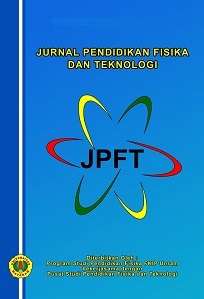Pengembangan Instrumen Five-Tier Newtonââ¬â¢s Laws Test (5TNLT) Untuk Mengidentifikasi Miskonsepsi dan Penyebab Miskonsepsi Siswa
DOI:
10.29303/jpft.v6i2.2018Published:
2020-12-31Issue:
Vol. 6 No. 2 (2020): Juli-DesemberKeywords:
Misconceptions, Newton's Laws, Five-Tier Newton's Laws Test (5TNLT), 4D ModelArticles
Downloads
Additional Files
How to Cite
Downloads
Metrics
Abstract
This study aims to identify students' misconceptions on Newton's Law using the Five-Tier Newton's Laws Test (5TNLT) instrument. The process of identifying misconceptions is carried out as one of the first steps to overcome student misconceptions. The method used in this study uses the 4D model (Defining, Designing, Developing, and Disseminating). Participants involved in this study consisted of 327 students (198 female and 129 male), who came from 2 public high schools and 1 private high school in Bandung. Based on the research, it was found that the 5TNLT instrument developed by the researcher could be used to identify misconceptions and causes of students' misconceptions on Newton's Law. All items on the 5TNLT instrument are valid and reliable enough to measure student misconceptions. The highest percentage of misconception categories is shown in the MC-PT (Misconception from personal thoughts) category, which is 50.21%, while the smallest percentage is shown in the MC-I (Misconception from the internet) category, which is 14.82%.
References
Aiken, L. R. (1985). Three Coefficients for Analyzing the Reliability and Validity of Ratings. Educational and Psychological Measurement, 45(1), 131ââ¬â142. DOI:10.1177/0013164485451012.
Alwan, A. A. (2011). Misconception of Heat and Temperature Among Physics Students. Procedia Social and Behavioral Sciences, 600-614. DOI: 10.1016/j.sbspro.2011.02.074.
Caleon, I. S., & Subramaniam, R. (2010b). Do Students Know What They Know and What They Donââ¬â¢t Know? Using a Four-Tier Diagnostic Test to Assess the Nature of Studentsââ¬â¢ Alternative Conceptions. Research Science Education, 40:313ââ¬â337. DOI: 10.1007/s11165-009-9122-4.
Fratiwi, N. J., Kaniawati, I., Suhendi, E., Suyono, I., & Samsudin, A. (2017). The Transformation of Two-tier Test into Four-tier Test on Newton's Laws Concepts. AIP Conference Proceedings 1848, 050011, DOI: https://doi.org/10.1063/1.4983967.
Hançer, A. H., & Durkan, N. (2008). Turkish Pupils Understanding of Physical Concept: Force and Movement. World Applied Sciences Journal, 3 (1): 45-50. ISSN: 1818-4952.
Hermita, N., Suhandi, A., Syaodih, E., Samsudin, A., Isjoni, Johan, H., . . . Safitri, D. (2017). Constructing and Implementing a Four Tier Test about Static Electricity to Diagnose Pre-service Elementary School Teacherââ¬â¢ Misconceptions. Journal of Physics Conference Series, DOI: 10.1088/1742-6596/895/1/012167.
Hestenes, D., Wells, M., & Swackhamer, G. (1992). Force Concept Inventory. The Physics Teacher, Vol. 30, 141. DOI: 10.1119/1.2343497.
Kaltakci-Gurel, D., Eryilmaz, A., & McDermott, L. C. (2017). Development and Application of A Four-Tier Test to Assess Pre-Service Physics Teachersââ¬â¢ Misconceptions About Geometrical Optics. Research in Science & Technological Education, DOI: 10.1080/02635143.2017.1310094.
Kaniawati, I., Fratiwi, N. J., Danawan, A., Suyana, I., Samsudin, A., & Suhendi, E. (2019). Analyzing Studentsââ¬â¢ Misconceptions about Newtonââ¬â¢s Laws through Four-Tier Newtonian Test (FTNT). Journal of Turkish Science Education, 16(1), 110-122. DOI: 10.12973/tused.10269a.
Kirbulut, Z. D., & Geban, O. ( 2014). Using Three-Tier Diagnostic Test to Assess Studentsââ¬â¢ Misconceptions of States of Matter. Eurasia Journal of Mathematics, Science & Technology Education, 10(5), 509-521. ISSN: 1305-8223.
Liliawati, W., & Ramalis, T. R. (2009). Identifikasi Miskonsepsi Materi IPBA di SMA dengan Menggunakan CRI (Certainly of Respons Index) dalam Upaya Perbaikan Urutan Pemberian Materi IPBA Pada KTSP . Jurnal Pendidikan Teknologi dan Kejuruan, DOI: 197812182001122.
Maharani, L., Rahayu, D. I., Amaliah, E., Rahayu, R., & Saregar, A. (2019). Diagnostic Test with Four-Tier in Physics Learning: Case of Misconception in Newtonââ¬â¢s Law Material. Journal of Physics: Conference Series 1155, DOI: 10.1088/1742-6596/1155/1/012022.
Pesman, H., & Eryilmaz, A. (2010). Development of a Three-Tier Test to Assess Misconceptions About Simple Electric Circuits. The Journal of Educational Research, 103:208ââ¬â222. DOI:10.1080/00220670903383002.
Thiagarajan, S., Semmel, D. S., & Semmel, M. I. (1974). Instructional Development for Training Teacher of Exceptionl Children: A Sourcebook. National Center for Inprovement of Educational System (DHEW/OE), Washington, D.C.
Thornton, R. K., & Sokoloff, D. R. (1998). Assessing student learning of Newtonââ¬â¢s laws: The Force and Motion Conceptual Evaluation and the Evaluation of Active Learning Laboratory and Lecture Curricula. American Journal Of Physics, Vol. 66, 338. DOI: 10.1119/1.18863.
Zhou, S., Wang, Y., & Zhang, C. (2016). Pre-Service Science Teachersââ¬â¢ PCK: Inconsistency of Pre-Service Teachersââ¬â¢ Predictions and Student Learning Difficulties in Newtonââ¬â¢s Third Law. Eurasia Journal of Mathematics, Science & Technology Education, 12(3), 373-385. DOI: 10.12973/eurasia.2016.1203a.
Author Biographies
Imas Rosita, Universitas Pendidikan Indonesia
Winny Liliawati, Universitas Pendidikan Indonesia
Achmad Samsudin, Universitas Pendidikan Indonesia
License
Authors who publish with Jurnal Pendidikan Fisika dan Teknologi (JPFT) agree to the following terms:
- Authors retain copyright and grant the journal right of first publication with the work simultaneously licensed under a Creative Commons Attribution License 4.0 International License (CC-BY-SA License). This license allows authors to use all articles, data sets, graphics, and appendices in data mining applications, search engines, web sites, blogs, and other platforms by providing an appropriate reference. The journal allows the author(s) to hold the copyright without restrictions and will retain publishing rights without restrictions.
- Authors are able to enter into separate, additional contractual arrangements for the non-exclusive distribution of the journal's published version of the work (e.g., post it to an institutional repository or publish it in a book), with an acknowledgement of its initial publication in Jurnal Pendidikan Fisika dan Teknologi (JPFT).
- Authors are permitted and encouraged to post their work online (e.g., in institutional repositories or on their website) prior to and during the submission process, as it can lead to productive exchanges, as well as earlier and greater citation of published work (See The Effect of Open Access).











